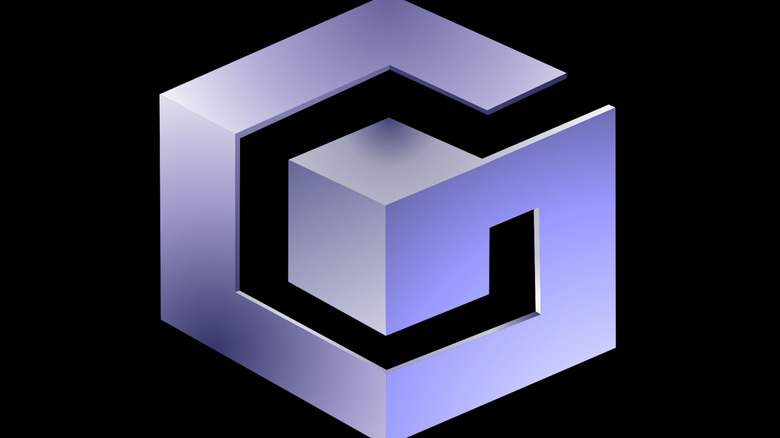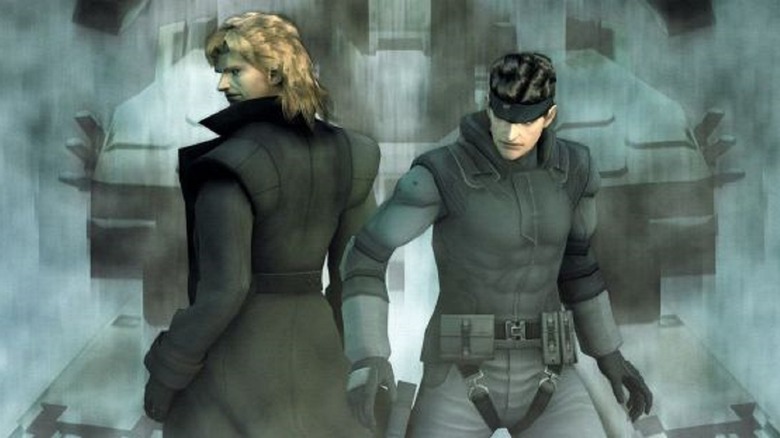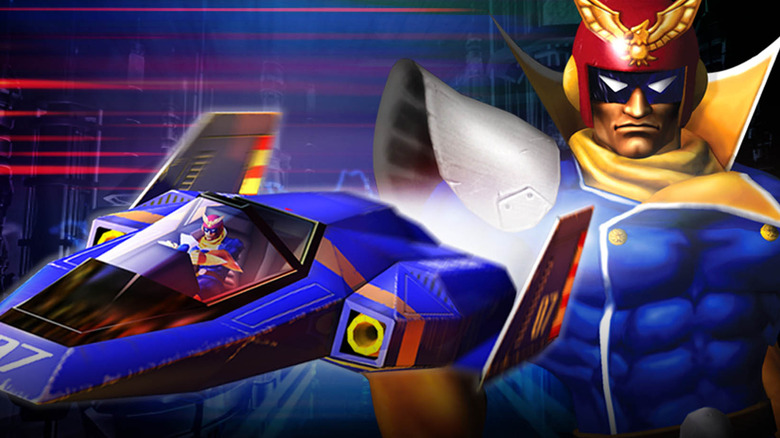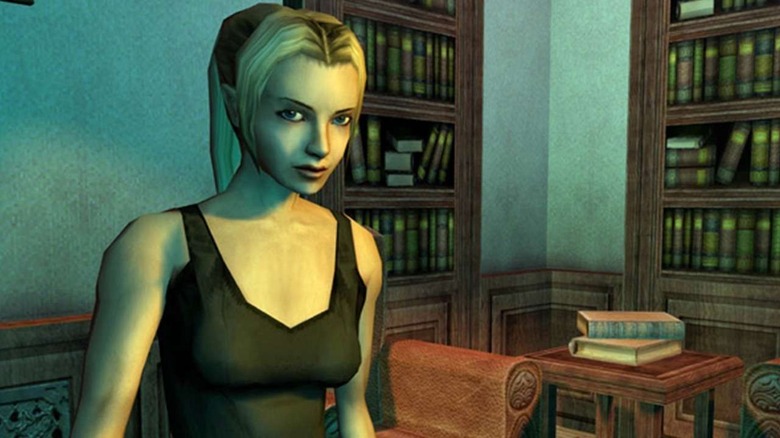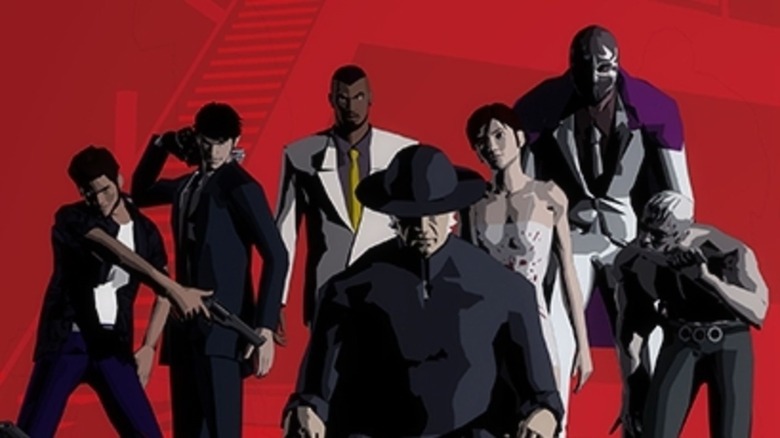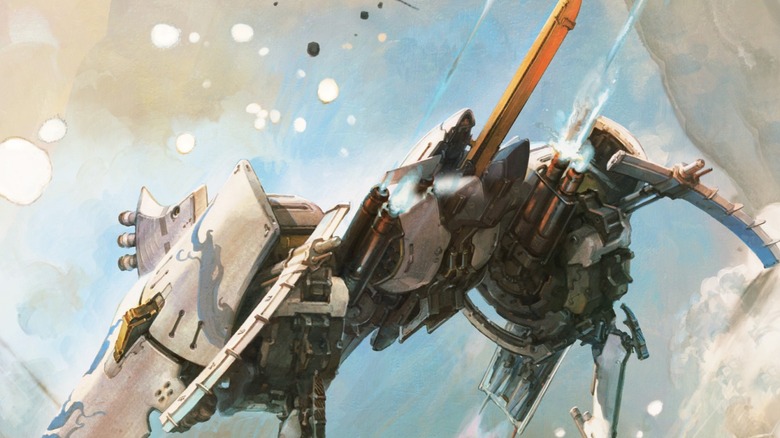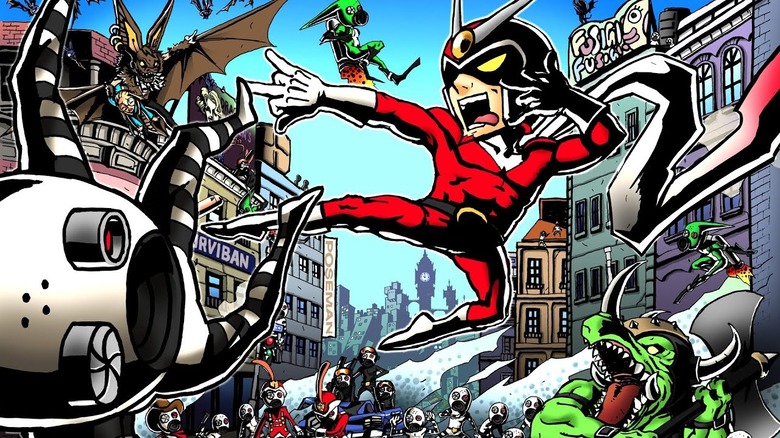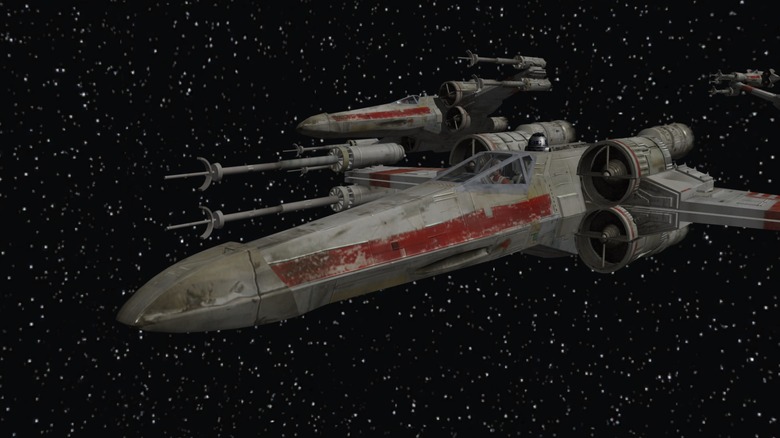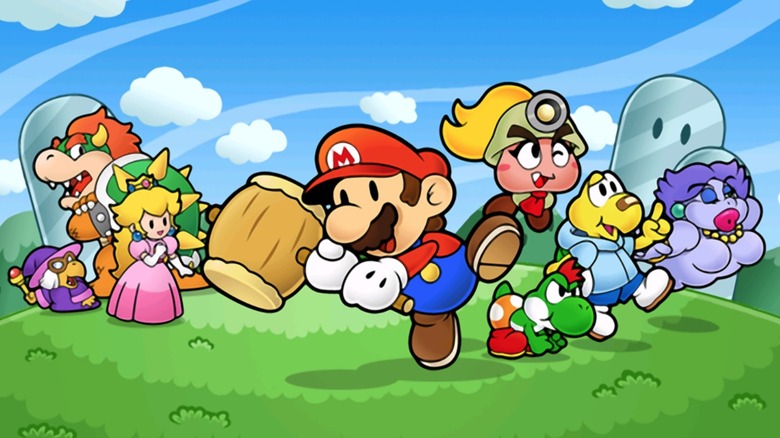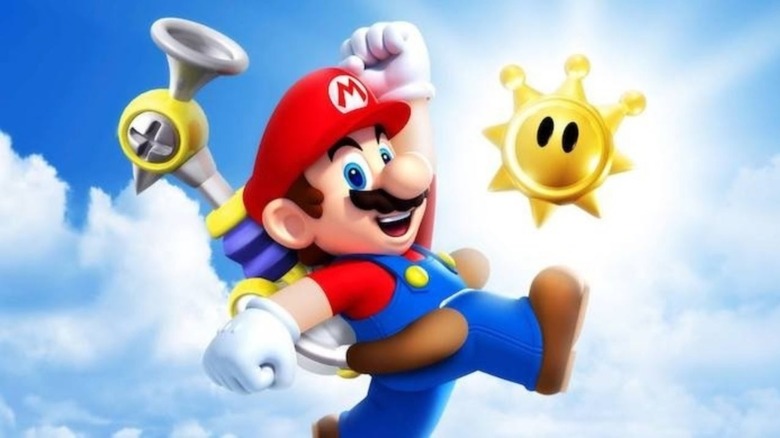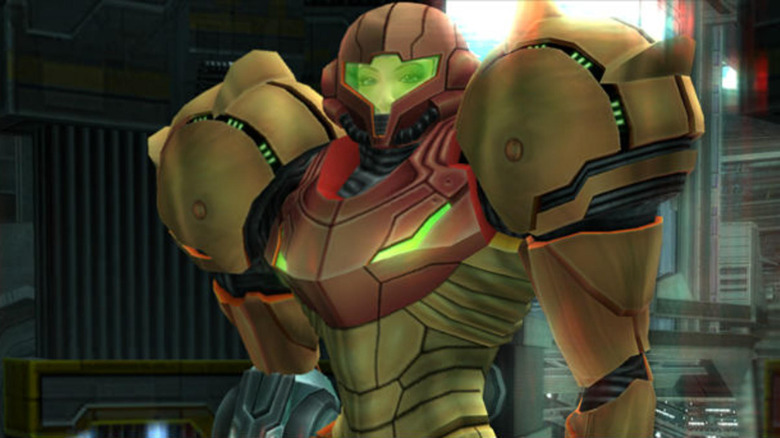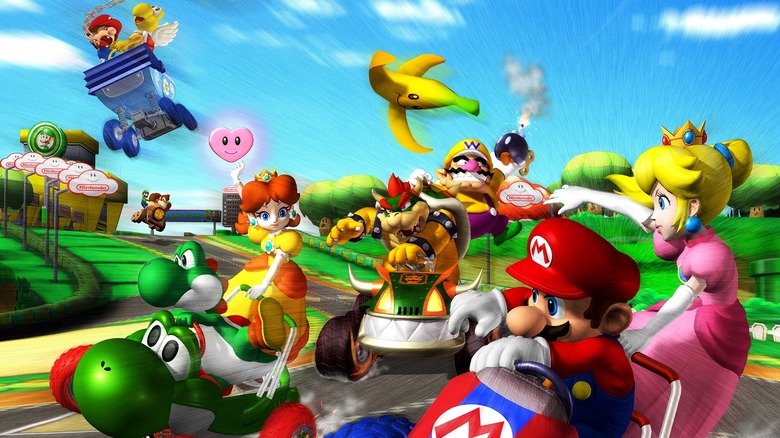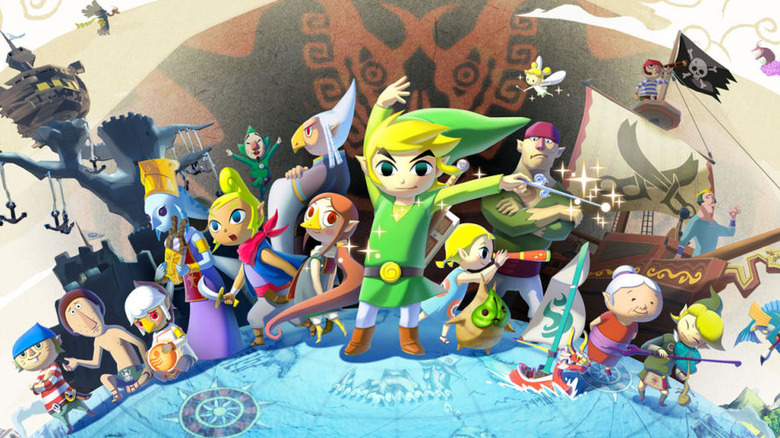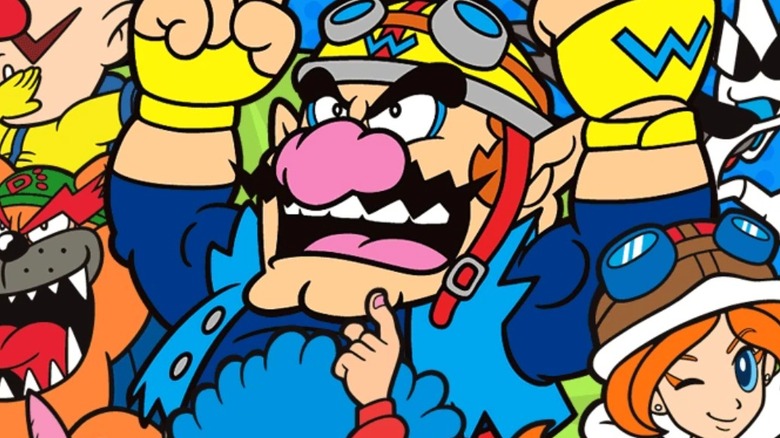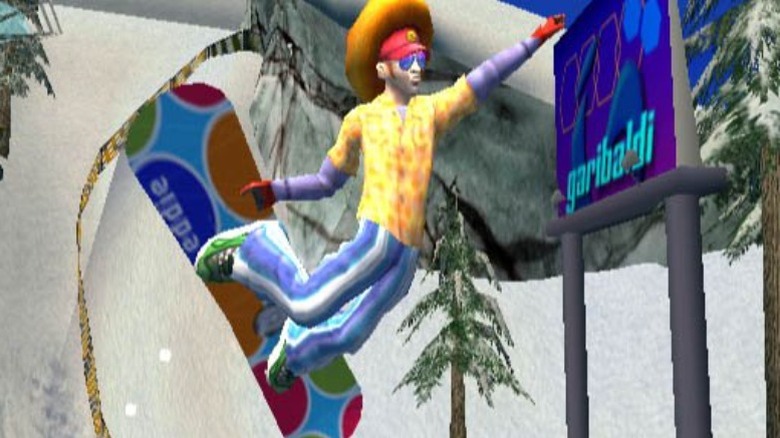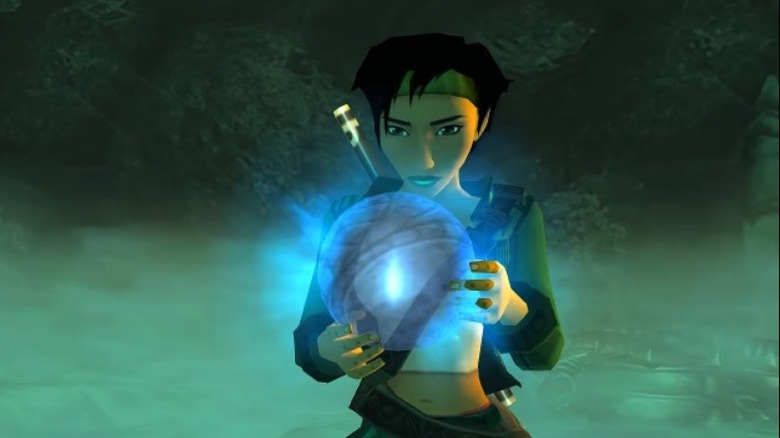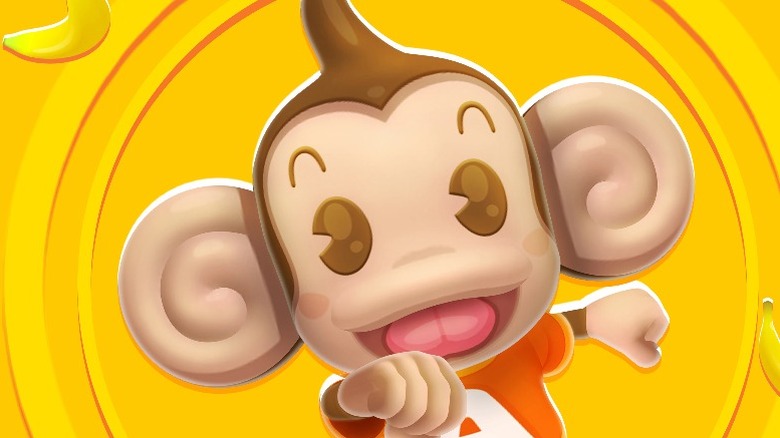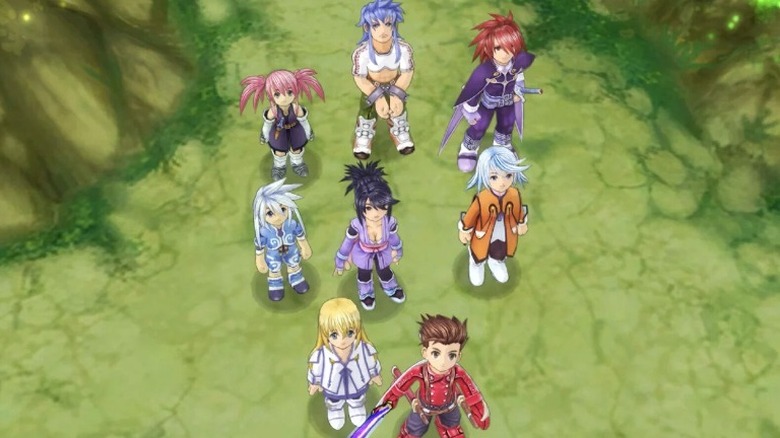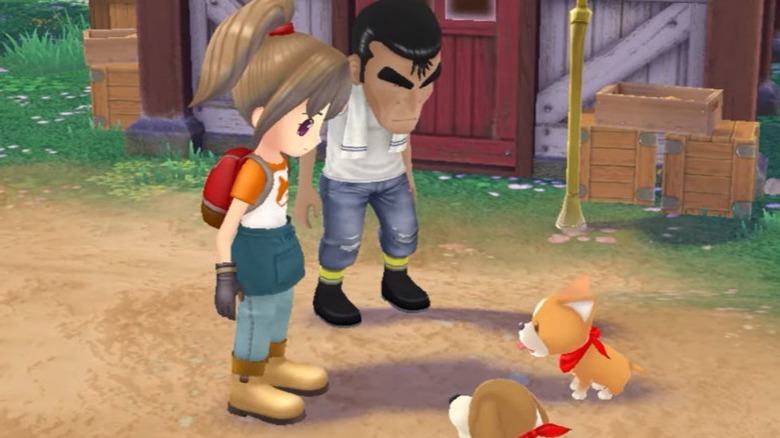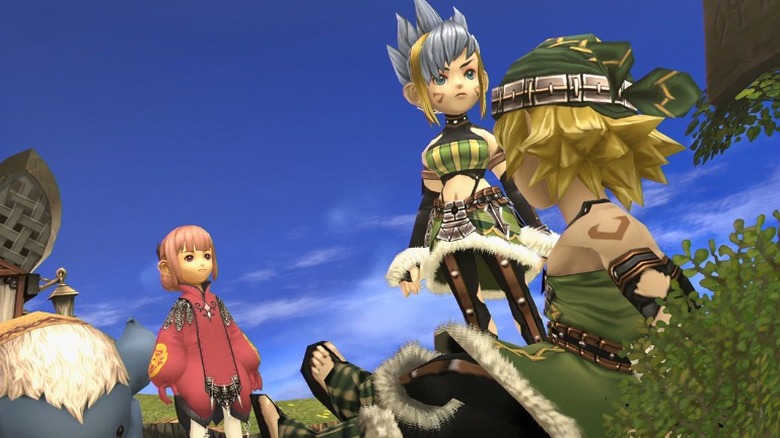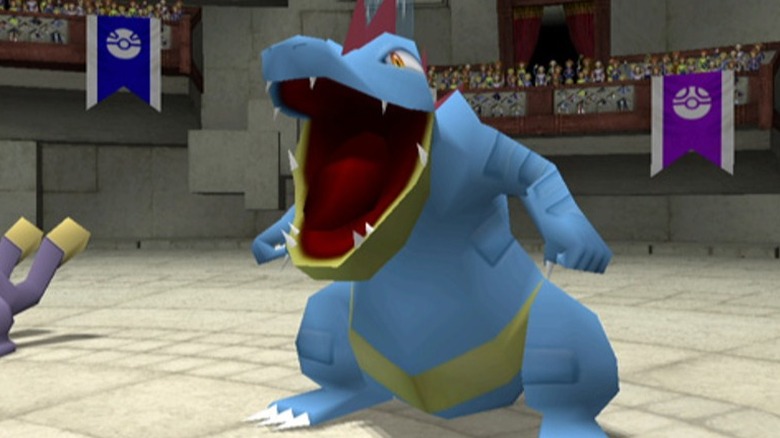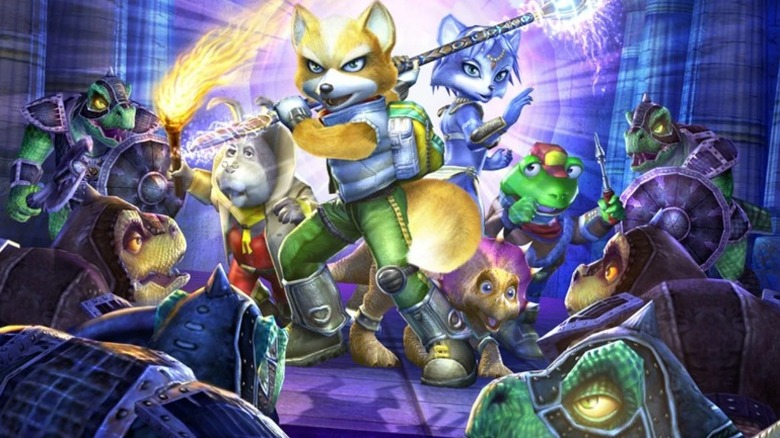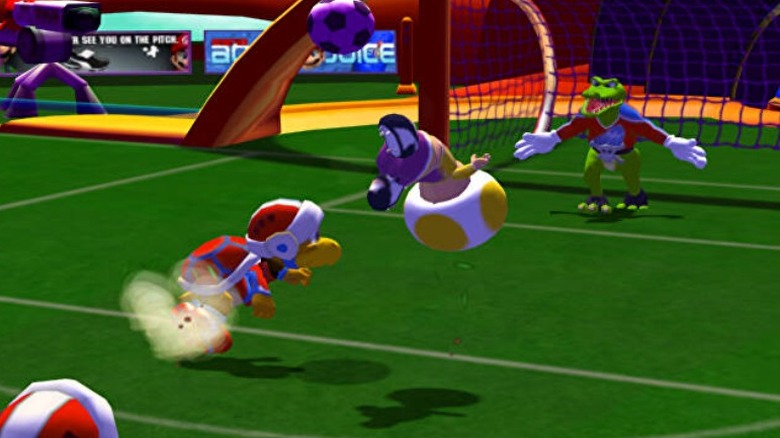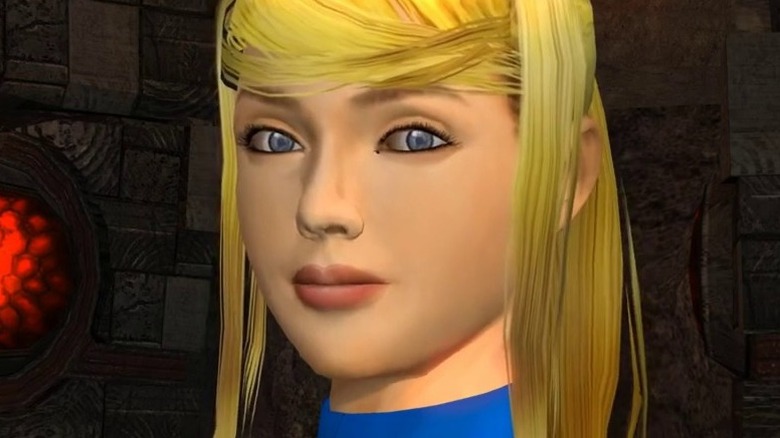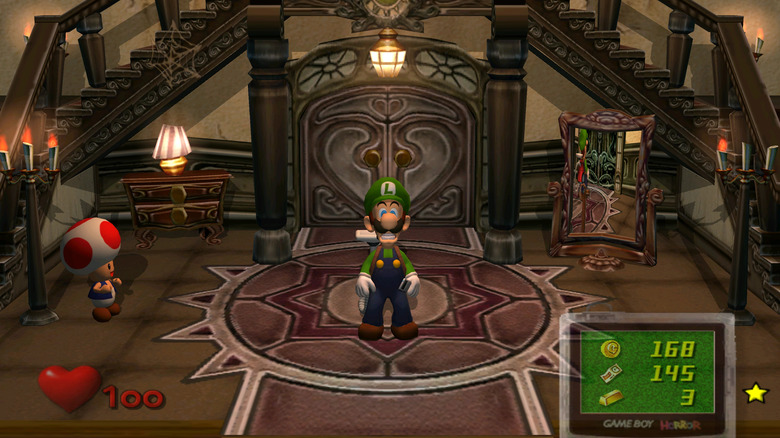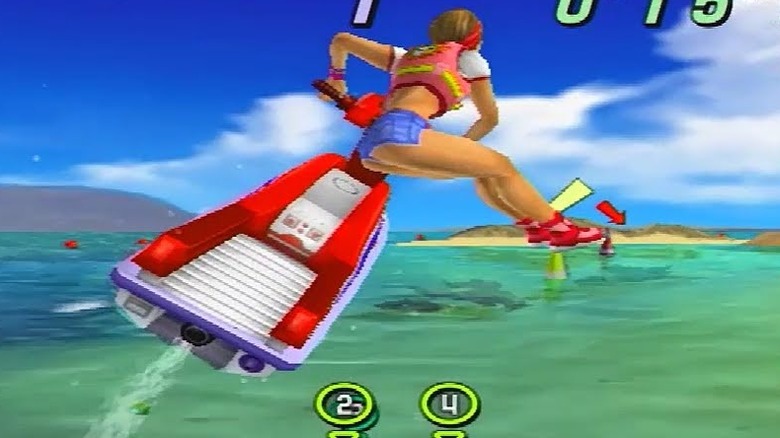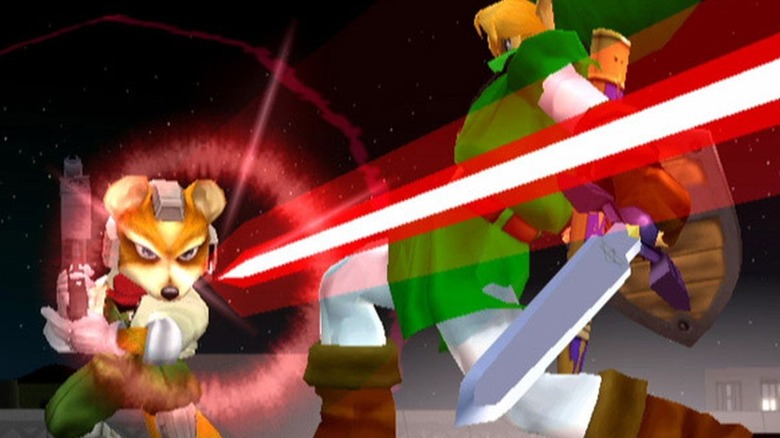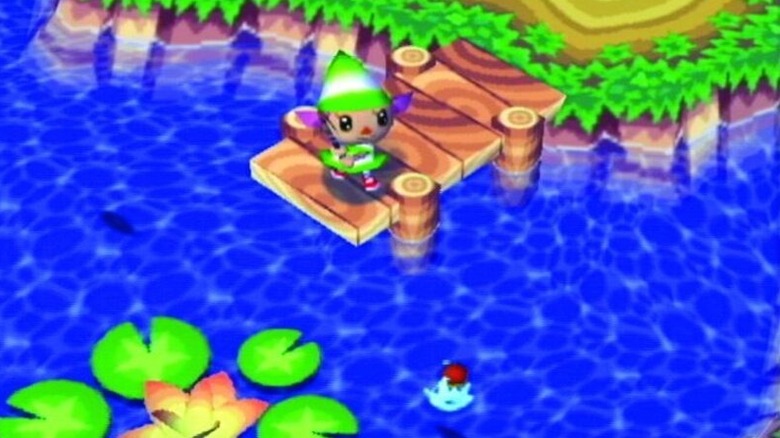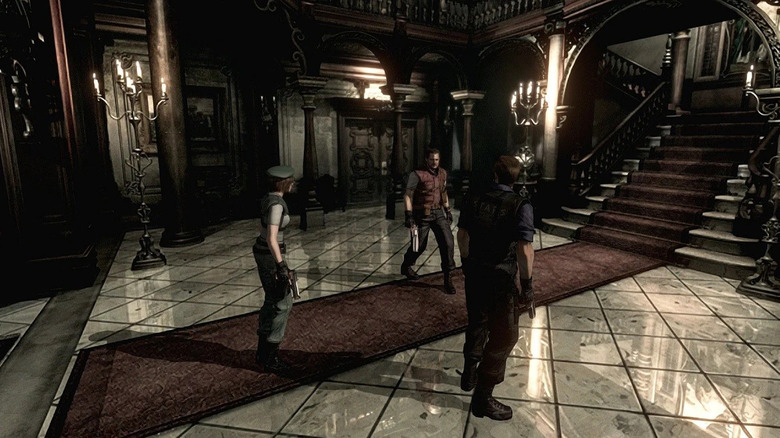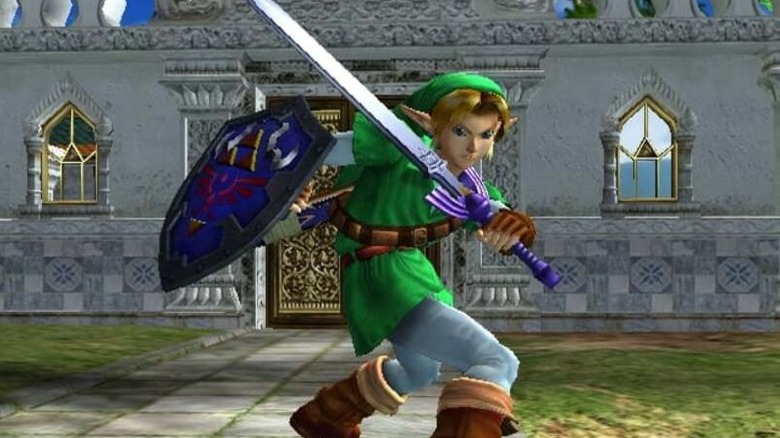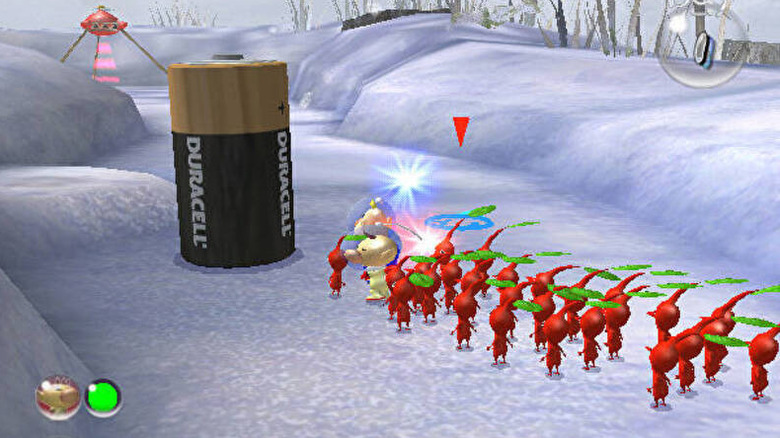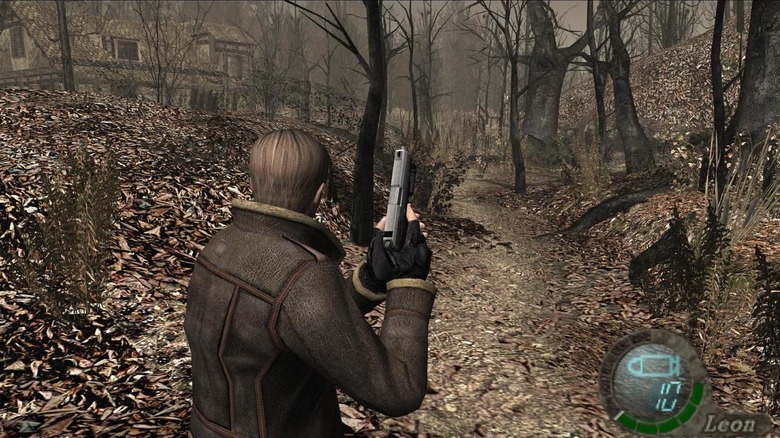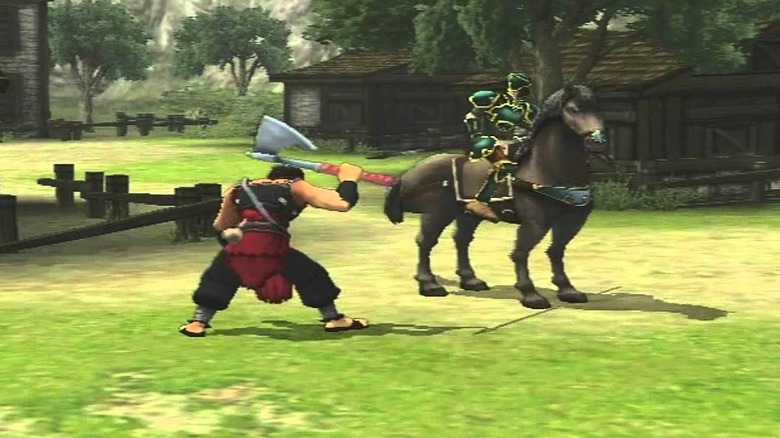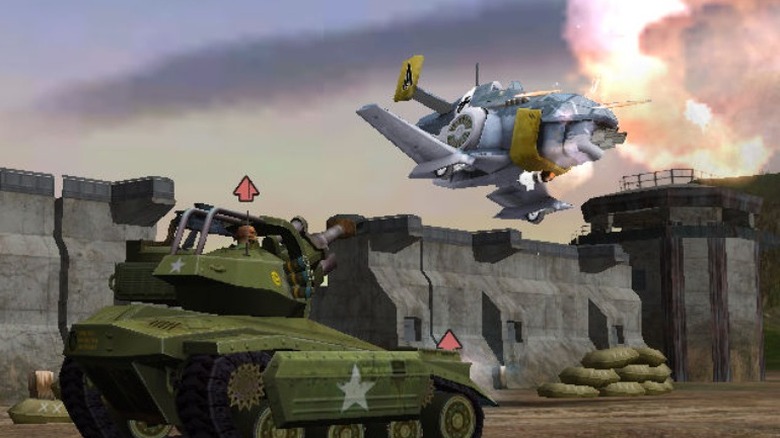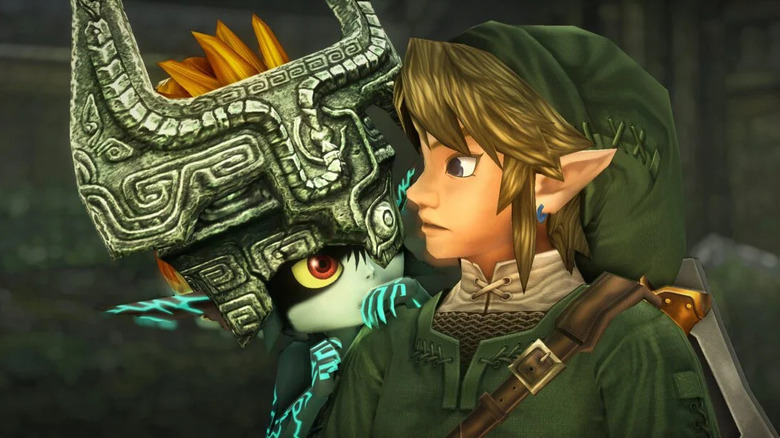The 34 Best GameCube Games Of All Time
Nintendo's GameCube holds such a strange place in the annals of gaming history. It was basically the middle child in every aspect it could've been. In terms of Nintendo's legacy, it's sandwiched between the game-changing N64, and the outsized, asterisked success of the Wii. In terms of the console war of the time, it was just sort of there at a time when Microsoft had come for Sony's blood. When Sony went sleek and cool with the design of the PS2, and Microsoft went bulky and intimidating, the GameCube went compact and playful. Even in terms of horsepower, it was more powerful than the PS2, less powerful than the Xbox, and accompanying neither extreme, most of its positives went underappreciated.
That's a special kind of disservice, since quite a few of the best games of that gen were GameCube exclusives, caught in limbo between warring gods, which is probably the exact reason why everything from the Wii onward has seen Nintendo operating on their own terms. But there's absolute gold on the old cube that deserved better. Here are the absolute best games for the Nintendo GameCube.
Metal Gear Solid: The Twin Snakes
Long before the HD remaster/remake train well and truly left the station in the 360/PS3 era, Metal Gear Solid: The Twin Snakes showed everybody how it could and still should be done. It helps, of course, that the jump between graphics on the PS1 and graphics on the GameCube was huge, but nothing had gone the extra mile the way this had at the time. The entirety of Metal Gear Solid was, essentially, remade in the Metal Gear Solid 2 engine by Silicon Knights at the height of their creative powers, with new voice acting from the original cast, and the cutscenes completely redone by Ryuhei Kitamura, aka one of the craziest action directors on the planet. All while being supervised by Kojima himself and a hands-on Shigeru Miyamoto.
Even with the horsepower available to developers now, it's the kind of worshipful effort you just don't see for a game, let alone one as extensive and detailed as MGS.
-
Release Date: March 9, 2004
-
Genre: Action, Stealth
-
Game modes: Single-player
-
Metacritic score: 85
F-Zero GX
For a game that's still one of the crown jewels of the SNES-era — an SNES launch title, in fact! — F-Zero's cultural cache in the modern age is depressingly small, mostly relegated to Captain Falcon being a Super Smash Bros. mainstay (and the Falcon Punch still being ridiculously OP, but that's a whole other article). The best theory on why pretty much just boils down to Wipeout on PlayStation basically making F-Zero's cartoony graphics look a little juvenile by comparison.
That's still true in F-Zero GX. Nobody remembers that game for its utterly ridiculous cutscenes, after all. But those who do remember F-Zero GX fondly do so not just for being eye-poppingly fast, but for making that speed feel absolutely deadly in the process. Speed has consequences as you race in GX, but the rewards in zooming at thousands of miles an hour down a track sometimes the width of a ruler is still one of the most breathtaking racing experiences ever crafted.
-
Release Date: June 25, 2003
-
Genre: Racing
-
Game modes: Single-player, multiplayer (up to 4)
-
Metacritic score: 89
Eternal Darkness: Sanity's Requiem
It's been so long, and so much has happened, that it's hard to remember. But we assure you: once upon a time, Silicon Knights were respected.
For PlayStation owners, Silicon Knights were the folks behind Legacy of Kain: Blood Omen, a second-wave PS1 game that didn't sell great and was eventually overshadowed by its grandiose spinoff, Soul Reaver. But the GameCube got Silicon Knights' magnum opus, a down and dirty, history-spanning little beast called Eternal Darkness. On its own, it's basically a Lovecraft-style compendium of terror, chronicling centuries of horrors across the world within a book made of human skin. It's truly grisly, ambitious, and compelling stuff, with a timbre and scale unlike anything before, or even since.
The cherry on top, however, is that the game actively trolls its players, with a sanity meter that would inflict all sorts of fourth-wall breaking hindrances on the player and their poor, abused save file. The closest analogue is the save state shenanigans near the end of Undertale, but even that never went as far as Eternal Darkness. To this day, it's still a wholly unique horror experience, and despite even Silicon Knights' best — er, well, let's just call them notable — efforts, it's one you could only get on the GameCube.
-
Release Date: June 24, 2002
-
Genre: Action, adventure, psychological horror
-
Game modes: Single-player
-
Metacritic score: 92
Killer7
If gaming has anything resembling a David Lynch, able to make absolutely mindblowing choices within the context of tired genres, it's Suda51. While he'd been making bizarre little point-and-click adventures before, and his resume afterward certainly didn't get any easier to parse, Suda's breakout game, Killer7, is simultaneously his most accessible title and also the most psychologically baffling.
On paper, it's easy to say Killer7's little more than a glorified rail shooter, with some light puzzle-solving for spice. But the reality is obvious within minutes of starting the game. Right at the outset, our main character dissolves away in a haze of white noise, something he's able to do to turn into seven wildly dissociated personalities. Even that's just the tip of the iceberg for a game that ends up being an unhinged, Kojima-esque take on government corruption, all rendered in a weirdly unsettling abstract cel-shaded noir aesthetic that just accentuates the weird. It's not the kind of game you typically look for or would ever expect to get on a Nintendo system — and that's even in a world where the Wii got the No More Heroes games — but it's certainly one to be grateful for, regardless.
-
Release Date: June 9, 2005
-
Genre: Action, shooter
-
Game modes: Single-player
-
Metacritic score: 74
Ikaruga
When the Dreamcast died — rest its poor soul — its legacy would, by and large, be carried forward by the original Xbox. While most of the system's best games would get a second life later, there were a few stragglers, and somehow, the GameCube would inherit one of its best in Ikaruga.
As much as your typical bullet hell shooter is a careful feat of maneuvering hitboxes and pattern recognition, Ikaruga adds a whole new element of red/white color immunity, which essentially makes navigating the game into a frightening dance of not just avoiding getting shot, but getting shot the right way, at the right place, at the right time. It's a gimmick so immensely versatile that the game is designed so that you can beat it without firing a single shot, absorbing everything in your way instead.
As meticulous and frighteningly beautiful as a game like this normally is, it's rare they require a player to be equally as graceful. It's a unique game that belonged on a unique system. And with the Dreamcast out of the picture, it's only right it ended up on the Cube.
-
Release Date: Jan. 16, 2003
-
Genre: Action, shooter
-
Game modes: Single-player, two-player co-op
-
Metacritic score: 85
Viewtiful Joe
Before Platinum Games was, well, Platinum Games, the vast majority of their development team worked at Capcom under the name Clover Studios. Clover wasn't nearly as prolific as their current iteration, though the fact that they made Okami before they even became Platinum Games should be enough to drop a few jaws. But while that game is considered a masterpiece, their previous title was just as unique, but much more woefully overlooked.
Viewtiful Joe has all the hallmarks that we identify with Platinum today: the hard-hitting combo-based fights, the slo-mo mechanics, the obsessive hat tips to popular films — in this case, the entire plot happens because Joe's girlfriend gets sucked into a movie, Last Action Hero-style. The difference, however, is the 2D formatting, the cel-shaded art style, and some rather ingenious sections where Joe has to use those hard-hitting powers to not just ruin his enemies, but solve traversal puzzles. It's a mix that nobody would really attempt until Guacamelee some ten years later, which goes to show just how far ahead of the curve Platinum's staff really was.
-
Release Date: June 26, 2003
-
Genre: Beat'em-up
Advertisement -
Game modes: Single-player
-
Metacritic score: 93
Star Wars: Rogue Leader
There have been dozens of games that tried to transport players into the Star Wars universe, and, generously, maybe half are more than just one-off time-wasters with a John Williams soundtrack. Unless you owned a PC, games that truly put you behind the stick of an X-Wing were thin on the ground for a long time. It wasn't until Factor-5 absolutely aced Rogue Leader that the experience felt fully realized.
It all just feels right: The rock-solid framerate meant that the dogfights felt like real-life pulse-pounding dogfights. The score came through crystal clear. The X-Wings themselves felt fast and fluid, but then, it took you that extra step further, giving players a full-fledged story with Wedge Antilles taking center stage with spectacular guerilla airstrikes against the Empire. It's all just perfect, and even with stuff like Battlefront 2 making things prettier than before, Rogue Leader is still a delight.
-
Release Date: Nov. 18, 2001
-
Genre: Action
-
Game modes: Single-player
-
Metacritic score: 90
Paper Mario: The Thousand Year Door
It's a sobering thing to look at the RPGs that came out in 2004. This is the year that brought us World of Warcraft, Vampire: The Masquerade, Star Wars: Knights of the Old Republic 2, and the first Fable. And right smack in the middle of all that is Paper Mario: The Thousand Year Door, as weird and wacky as it can be, at the most angsty and staunchly traditional time for RPGs ever.
Paper Mario games have rarely tried to reinvent themselves, but they've also never had to. It's only very recently that RPGs have lightened up to the point where a Paper Mario game's cheery take on RPG tropes isn't a wild departure from everything else it would share shelf space with. For Thousand Year Door, its greatest innovation is taking fuller advantage of the paper aesthetic, with Mario able to turn himself into paper airplanes, background elements depending on Mario himself, and the environment folding into various shapes. There's such a self-awareness, humor, and lightness to the whole thing that it stands out in the GameCube's library.
-
Release Date: July 22, 2004
-
Genre: RPG
-
Game modes: Single-player
Advertisement -
Metacritic score: 87
Super Mario Sunshine
Every once in a while, Nintendo gets a wild urge to throw a wrench into the typical Mario game formula, and not always at the opportune time. In Sunshine's case, trying to put out a game so wildly divergent when they hadn't made a 3D Mario game in eight years was probably not ideal, but since when has Nintendo gotten anywhere doing exactly what people expect?
While history prematurely consigned Sunshine to black sheep status, as part of a series of far-thinking innovations for the series, it's not hard to draw a straight line between Super Mario Sunshine and Splatoon. The gimmick of Mario having to strap on a water-hose and do environmental cleanup, as opposed to just hopping on every enemy in sight, probably could've used a bit more time to polish up; but as it stands, it still employs a series of unique gameplay ideas and daunting platform segments that we wouldn't see from the series for years afterwards.
-
Release Date: July 19, 2002
-
Genre: Platformer
-
Game modes: Single-player
-
Metacritic score: 92
Metroid Prime
Metroid is, and always has been, a strange case for Nintendo. It's popular in the West, but not in Japan. Nintendo doesn't necessarily hate it, but there's always been a sort of benign neglect that means they only really address the series when they get around to thinking about it.
As such, unlike the vast majority of their other properties, they've always left the good work of carrying on the series to studios in the West or friendly to the West. Luckily for them, the result has been some of the best first person shooters ever crafted, and it all starts with the incredible first Metroid Prime.
It's hard to imagine now, but there once was a moment where everyone was worried Metroid wouldn't make the jump to 3D very well. But it doesn't take long after Samus' ship lands on the Space Pirate station for the game to feel every bit as natural as its 2D counterparts. But even beyond that, Retro Studios also manages to capture that lonely feeling, a mood of truly being stranded someplace alien and hostile but beautiful. All the while, they manage to make precision aiming work in a way that still stands up to scrutiny. They even managed to implement platforming, something it would take most other FPS franchises years to get right.
-
Release Date: Nov. 18, 2002
-
Genre: Action, FPS, Metroidvania
-
Game modes: Single-player
-
Metacritic score: 97
Mario Kart: Double Dash
Generally, if a Nintendo game has Mario in the title, it's a pretty sure bet it's quality, but that's been especially true of Mario Kart. But even in that series, there's a pecking order, and if Double Dash isn't at the top of it, it's pretty close.
For the most part, it's business as usual for Mario Kart's special mix of white knuckle racing, insane obstacles, and gleefully evil items to smite one's enemies with, but Double Dash's stroke of genius has players racing to the finish line as a duo. One player drives, the other is essentially your side-seat gun moll, or shell moll as it were.
The result is a game that was already pure mayhem turn into the wildest chases imaginable, and that's if you're playing alone. Manage to connect two GameCubes up via LAN and make a 16-player match happen, and you're looking at some of the purest sources of chaos in not just the series, but in the entire arcade racing genre.
-
Release Date: Nov. 7, 2003
-
Genre: Racing
Advertisement -
Game modes: Single-player, multiplayer (up to 8)
-
Metacritic score: 87
The Legend of Zelda: The Wind Waker
There's an interesting throughline for many of the GameCube's best titles: they're ideas that, on paper, a lot of folks thought wouldn't work. For the most part, Nintendo proved all those naysayers wrong, but there's no one game this century that gamers owe more of a mea culpa to than The Legend of Zelda: The Wind Waker.
Nintendo did themselves a bit of a disservice by including that now-infamous tech demo of a more realistic Link fighting Ganon at the GameCube's big coming out party, and then announcing the next Zelda would be cel-shaded. But it's never a good idea to underestimate Nintendo, and pretty much every angry internet tough would go completely silent when they realized that Wind Waker is one of the more impeccably crafted Zelda titles in the series, brimming with charm, humor, ingenious puzzles, an exhilarating seafaring aspect, and a no-nonsense Princess Zelda unlike anything in the series. Did even Sheik run a band of pirates? No Sheik didn't.
The game's legacy is all but cemented a couple of generations later, when it and Twilight Princess got prettied up for the Wii U. And yes, Twilight Princess remains pretty spectacular, but between the two, one of these games desperately misses motion controls, and the other feels timeless, and felt timeless since the day it released on GameCube.
-
Release Date: Dec. 13, 2002
-
Genre: Action, adventure
-
Game modes: Single-player
-
Metacritic score: 96
WarioWare, Inc.: Mega Party Game$
Some review outlets (like IGN) docked "WarioWare, Inc.: Mega Party Game$" a few points for essentially being a rehash of the original Game Boy Advance "WarioWare" title, but that's arguably not an entirely fair assessment. "WarioWare, Inc." brought the series' strange micro-game style to a major console for the first time, giving players a chance to easily compete against their friends in multiplayer mode or enjoy the short and sweet challenges all by their lonesome.
As with most "WarioWare" games, "Mega Party Game$" forced players to complete a variety of super-short minigames with bizarre premises. As noted by Nintendo Life, over 200 minigames are featured, including one that asks players to help guide a finger into an open nostril. In addition to all the games that players enjoyed on the original Game Boy Advance version, new multiplayer-specific games were added, making the title even more appealing for a GameCube audience. Part of the charm of all "WarioWare" games — but maybe specifically "WarioWare, Inc." — is that the directions for each game are often unclear, causing players to need to repeat the game to figure out their goals. This vagueness is equal parts frustrating and hilarious, and it brings players back even today.
-
Release Date: April 6, 2004
-
Genre: Puzzle, Party
-
Game modes: Single-Player, Multiplayer (up to 4)
-
Metacritic score: 76
SSX Tricky
Where many sports games skew towards realistic physics, "SSX Tricky" embraces its cartoonish nature, allowing its snowboarders to execute wild tricks and wear outlandish clothes on the course. "SSX Tricky" is sort of a sequel to 2000's "SSX," but it's not necessary to play the previous game to enjoy "Tricky." In fact, "Tricky" has a bit of a different style, giving a funkier aesthetic to its snowboarders, menus, and soundtrack.
IGN rightly noted that "SSX Tricky" was a port of the PlayStation 2 game that had released weeks before, and that the game ran better on the PlayStation 2. However, the GameCube simply didn't have anything else like "Tricky" available. With that in mind, IGN specifically praised the game's course designs, which are built to allow players to achieve the air necessary to execute big tricks. And what tricks they are: "Tricky" included the addition of "Uber Tricks," which are bigger and better than the sport's normal tricks in almost every way – just like the game itself.
-
Release Date: Dec. 2, 2001
-
Genre: Sports
-
Game modes: Single-Player, Multiplayer (up to 2)
-
Metacritic score: 87
Beyond Good & Evil
"Beyond Good & Evil" became a cult classic that left fans still clamoring for a sequel years later. Even though we may not see "Beyond Good & Evil 2" for a while, fans continue to love playing the Ubisoft title on GameCube. Some gamers are even picking it up for the first time years later, only to find that it holds up excellently well.
"Beyond Good & Evil" puts players in the shoes of Jade, a reporter investigating some shady connections between the protective Alpha Sections and the DomZ, a race of murderous aliens responsible for many disappearances around Hillys. Jade uses her martial arts abilities to protect herself as she goes about her missions, but she also heavily relies on her photography abilities to obtain proof of the corruption in the governing system. Jade can photograph animals around Hillys to earn money, but these photos also emphasize the nuanced ecosystem the world supports.
Though "Beyond Good & Evil" is relatively linear and features few sidequests, it affords players the feeling of an open-world, allowing them to wander and take a break when the story is getting too heavy – and it does get heavy. With an epic cliffhanger and intense final act, "Beyond Good & Evil" is the type of game that sticks with players for a long while.
-
Release Date: Dec. 11, 2003
-
Genre: Adventure
-
Game modes: Single-Player
-
Metacritic score: 87
Super Monkey Ball
"Super Monkey Ball" is a party game, allowing friends to race each other as they maneuver through tricky courses full of narrow pathways and tight corners. Of course, the players are monkeys rolling around the world in small transparent balls, as one might expect, but gamers don't actually control the spheres the monkeys are trapped in, but the course itself. The premise is deceptively simple, perhaps because – as IGN pointed out in its review – the game started as an arcade favorite. Sega chose to bring the arcade game to the GameCube and the rest is monkey history.
"Super Monkey Ball" rewards players who take their time and slowly maneuver the playing field to roll their character around carefully. However, speed is important in multiplayer, and part of the fun is seeing how your opponents navigate the risk versus reward style of the title. IGN commented that the game was simple, but completely engrossing. "Super Monkey Ball" features multiple modes of play, including one where the monkeys can be used as balls in an epic game of pool, which keeps things fresh when players tire of rolling around set courses.
-
Release Date: Nov. 17, 2001
-
Genre: Puzzle, action, party
-
Game modes: Single-Player, Multiplayer (up to 4)
-
Metacritic score: 87
Tales of Symphonia
"Tales of Symphonia" is perhaps the best-known title in the "Tales" series, and for good reason. The game boasts an epic soundtrack, expansive world, and rich characters, all of which work together to create a memorable RPG. Featuring a tried and true plot structure, "Tales of Symphonia" follows Lloyd as he travels with his childhood best friend on a quest to save the world. Of course, things go awry when Lloyd and his party find out what's really going on, and are faced with the most difficult decision they'll ever make.
In its retrospective review of "Tales of Symphonia," Nintendo Life pointed out that the GameCube was a bit light on RPGs, but that "Tales of Symphonia" stood out above the small crowd. "Tales of Symphonia" is an action RPG, much like the more recent "Final Fantasy 7 Remake," in which players control one character while their teammates operate on AI. Nintendo Life emphasized that the AI in the game is surprisingly impressive and actually cooperates as one would want – which is more than many RPGs offer.
-
Release Date: July 13, 2004
-
Genre: Action RPG
-
Game modes: Single-Player, Multiplayer co-op
-
Metacritic score: 86
Harvest Moon: A Wonderful Life
The "Harvest Moon" series has been chugging along, producing quality farming sims for years, but "A Wonderful Life" was one installment that stuck out like a prize-winning ear of corn. As IGN explained in its review, "A Wonderful Life" added new features to the formula, like the ability to raise a child to adulthood and a soil fertility system. These features made gamers feel like their farmer was really putting down roots in the community, with the intention for their ancestors to carry on in the same way for generations. Of course, gamers still had plenty of "Harvest Moon" staples to enjoy, like caring for a pet and getting to know townsfolk, but the family aspect of the game added a new dimension of time management strategy.
"A Wonderful Life" was the "Harvest Moon" game for the GameCube, so popular with farming sim fans that it's been remade for the Switch. While the franchise's name has changed, fans can expect "Story of Seasons: A Wonderful Life" to have many of the same qualities that made the original great, like an intricate marriage system and tons of crops to make the perfect farm.
-
Release Date: March 16, 2004
-
Genre: RPG, Farming sim
-
Game modes: Single-Player
-
Metacritic score: 79
Final Fantasy Crystal Chronicles
When it first released, "Final Fantasy Crystal Chronicles" was different from all of the other "Final Fantasy" games that came before it. Not only had "Final Fantasy" not had a relationship with Nintendo since the SNES, but it also hadn't delved into real-time, beat 'em up combat. "Crystal Chronicles" gave the franchise a chance to try out a new style of gameplay and take a break from the mainline series. It also adopted a cute, chibi art style.
In a review of "Crystal Chronicles," GameSpot pointed out that the game's multiplayer feature was fun, allowing friends to team up and combine spells with exciting results. "Crystal Chronicles" used the Game Boy Advance as controllers for multiplayer mode, meaning that each additional player had to have both a Game Boy Advance and a link cable to participate. While this was no doubt a barrier to entry for some, the small screen was a handy way for each individual player to keep up with their abilities while in the heat of battle. "Crystal Chronicles" received a remastered version in 2020, but the original holds up remarkably well.
-
Release Date: Feb. 9, 2004
-
Genre: Action, RPG
-
Game modes: Single-Player, Multiplayer (up to 4)
Advertisement -
Metacritic score: 80
Pokemon Colosseum
Unlike many other "Pokemon" games, "Pokemon Colosseum" takes out most of the narrative of the mainline games and focuses on what many players enjoy most: battling. Much "Pokemon Stadium" before it, "Pokemon Colosseum" maintains a laser focus on pitting the creatures against each other in fights, although it did have a single-player mode that focused on a trainer who rehabilitated mistreated Pokemon.
But the real fun of "Pokemon Colosseum" was multiplayer mode. IGN's review of "Colosseum" detailed how multiplayer mode married the mainline "Pokemon" games from the Game Boy with the more technologically advanced GameCube, allowing players to link their Game Boy Advance and a copy of "Pokemon Ruby" or "Sapphire" to bring their Pokemon to the big(ger) screen. This feature turned "Pokemon Colosseum" into an all-new 3D stage for players to show off their best pocket monsters, and gamers took notice.
-
Release Date: March 22, 2004
-
Genre: RPG, Turn-based battle
-
Game modes: Single-Player, Multiplayer (up to 4)
-
Metacritic score: 73
Star Fox Adventures
"Star Fox Adventures" looks a lot different from "Star Fox 64" before it, taking Fox McCloud out of the Arwing and onto an alien planet that he must work to save – with the help of some new friends, of course. While there are Arwing sequences that recall the gameplay of "Star Fox 64," "Star Fox Adventures" was a vast departure for the series, and it was more of an action-adventure game than an arcade shooter. The game also took advantage of the GameCube's technology to include more voice acting, replacing the garbled (but enchanting) voices of "Star Fox 64" will full-blown dialogue.
Nintendo Life pointed out that "Star Fox Adventures" is the last Nintendo game from beloved developer Rare, which was quickly acquired by Microsoft. While Nintendo Life claimed that "Star Fox Adventures" doesn't live up to some other Rare classics – like "Banjo Kazooie" – it definitely satisfies a love of adventure games. Plus, Fox has a cute little dinosaur pal to help him complete puzzles and grab items, and who doesn't love that?
"Star Fox Adventures" is also important because it introduces Krystal, a beautiful blue fox from a dying planet who's in search of answers about her home and family. She would later appear in "Star Fox: Assault," as well as in the form of a trophy in several "Super Smash Bros." games.
-
Release Date: Sept. 22, 2002
-
Genre: Action, adventure
-
Game modes: Single-Player
-
Metacritic score: 82
Super Mario Strikers
Nintendo fans know that Mario plays tons of sports in addition to being a friendly plumber and adventurer. However, many might not expect soccer to be in the mix of his favorite hobbies. "Super Mario Strikers" brought Mario and friends to the world of soccer, adding items and power boosts reminiscent of another "Mario"-themed sports franchise, "Mario Kart," to what would otherwise be an ordinary match. Even though the conceit is simple, the game is incredibly fun.
IGN praised the simplicity and lack of frills found in "Super Mario Stikers," writing, "'Super Mario Strikers' is the quintessential arcade sports game." The review said that for gamers looking purely for a multiplayer experience, the game might even hold more value, as its multiplayer mode provided a quick and easy way to play with friends. Even though its graphics aren't the most impressive thing on the GameCube, "Super Mario Strikers" makes up for its looks with accessibility; almost anyone can get the hang of it relatively quickly.
This game also yielded a healthy partnership. Years later, after working on many games together, Nintendo acquired Next Level Games, which worked on "Super Mario Strikers" and the "Luigi's Mansion" series, both of which have new games on the Nintendo Switch.
-
Release Date: Dec. 5, 2005
-
Genre: Sports
-
Game modes: Single-Player, Multiplayer (up to 4)
-
Metacritic score: 76
Metroid Prime 2
Fans haven't gotten a re-release of the "Metroid Prime" series for Switch just yet, which means that playing on the GameCube is still one of the best ways to experience the games. For those who love the trilogy, though, one stands out above the others for a few specific reasons.
Some fans have argued that "Metroid Prime 2: Echoes" is the best title in the trilogy, and maybe one of the best games of all time. One Redditor cited the game's setting, difficulty, and quality of life improvements as some of its strongest aspects. "Echoes" isn't a walk in the park, and the increased difficulty from its predecessor let gamers know that the stakes were high. Samus, as always, deals with life or death decisions in "Echoes," not just for herself but for entire civilizations. "Echoes" also improved almost everything gamers disliked about the first "Prime" game, allowing Samus to shoot while grappling and making other quality of life improvements that, while they didn't change the universe, made the game more enjoyable to play.
While gamers should check out the entire "Prime" series, "Echoes" definitely stands out as one of the best GameCube games of all time, worthy of a second, third, or tenth look from the gamers who love the series.
-
Release Date: Nov. 15, 2004
-
Genre: Action, FPS
-
Game modes: Single-Player, Multiplayer (up to 4)
-
Metacritic score: 92
Luigi's Mansion
Rather than having its usual mascot Mario leading the charge for the GameCube's launch, Nintendo put the focus on his brother for the 2001 game "Luigi's Mansion." After Mario goes missing in a haunted house he mysteriously inherited, Luigi investigates what happened to his sibling while trapping ghosts with the experimental Poltergust 3000. As Luigi progresses into the mansion, clearing it of malevolent spirits room-by-room, he discovers a secret treasure defended by a sinister host of specters.
More than just a fun twist on the "Super Mario" franchise, "Luigi's Mansion" provided players with a technical showcase for the GameCube. Featuring more detailed textures, gorgeously rendered environmental effects, and a richer sound design, "Luigi's Mansion" was a far leap ahead of the Nintendo 64 — and it managed to pack in some real scares! "Luigi's Mansion" was well-received critically and commercially, quickly becoming the most successful title in the GameCube's launch window (per BBC).
-
Release Date: Sept. 14, 2001
-
Genre: Action-adventure
-
Game modes: Single-player
-
Metacritic score: 78
Wave Race: Blue Storm
After its successful revival on the Nintendo 64, the water-based racing series "Wave Race" continued on the GameCube with the launch title "Wave Race: Blue Storm." A group of jetski racers — including characters from the N64 game "1080 Snowboarding" — come together for a new racing competition on a variety of tracks, including some returning locales. "Blue Storm" served as an all-around improvement from its predecessor while offering considerably more gameplay depth, including new tricks, strategies, and gameplay modes to test out.
"Blue Storm" doesn't significantly shake up the "Wave Race" formula. But in the game's defense, that also doesn't appear to be a major goal. Instead, the GameCube title provides a huge boost to the water and weather effects as part of its absolutely gorgeous technical presentation (per Eurogamer), giving the series a major facelift. One of the best racing games on the GameCube, "Wave Race: Blue Storm" offers plenty of fun in the sun, buoyed by an engaging physics engine and environmental variation to keep players on their toes.
-
Release Date: Sept. 14, 2001
-
Genre: Racing
-
Game modes: 1-4 players
-
Metacritic score: 80
Super Smash Bros. Melee
Of all the games released for the GameCube, the most successful title for the console is 2001's "Super Smash Bros. Melee," selling over seven million copies across its life cycle (per Nintendo). The second installment in the fighting game series, "Melee" brings together a cast of iconic characters from Nintendo's first-party properties for a variety of gameplay modes to duke it out for supremacy. "Melee" features the return of the original playable roster and significantly expands its offering of characters, stages, items, and modes, all while noticeably tightening the gameplay.
IGN's review of the game labeled "Melee" as an all-around improvement over its predecessor, praising its refined presentation and sheer depth. With a myriad of single-player modes and an impressive set of options for customize multiplayer matches, "Melee" defined the "Super Smash Bros." for years to follow. Players also immediately responded enthusiastically to the fighting game, which still enjoys a robust esports following to this day.
-
Release Date: Nov. 21, 2001
-
Genre: Fighting
-
Game modes: 1-4 players
-
Metacritic score: 92
Animal Crossing
"Animal Crossing" has become a bonafide global phenomenon for Nintendo, and the franchise came to international attention on the GameCube. Players take on the role of a villager moving to a remote town. They are then greeted by friendly (and adorable) inhabitants as they try to work off their debt to local shopkeeper Tom Nook. Featuring a real-time clock, the game sees players design their homes and the surrounding village to their liking, with up to four players residing in town at a time.
Much of the tried-and-true gameplay formula to the "Animal Crossing" series is present right from its inaugural installment, which is a testament to its continued appeal and relevance. Populated by plenty of fan-favorite characters and nods to Nintendo's wider history, "Animal Crossing" became one of the bestselling titles on the GameCube (per VentureBeat). An unassuming slice-of-life adventure that provides limitless entertainment and rewards players for being good neighbors, "Animal Crossing" still offers a refreshing change of pace.
-
Release Date: Dec. 14, 2001
-
Genre: Life simulation
-
Game modes: Single-player
-
Metacritic score: 87
Resident Evil (2002)
In the early 2000s, Capcom partnered with Nintendo to bring "Resident Evil" games to the GameCube, with the first project blending old and new. As the console received updated ports of "Resident Evil 2" and "Resident Evil 3: Nemesis," franchise creator Shinji Mikami decided to remake the original "Resident Evil" from scratch. This resulted in a gorgeously realized redo on the GameCube in 2002, which retained the story from the 1996 game with updated controls and the most haunting visuals on the console.
After an elite police squad goes missing just outside of Raccoon City, the team sent to find them are forced to shelter in a nearby mansion, where they face ravenous zombies. Gamers play as Jill Valentine and Chris Redfield, each of whom endure their own horrifying experiences in this survival horror adventure.
In a statement to IGN, Capcom marketing director Todd Thorson explained that Capcom saw the GameCube partnership as a way to "achieve motion picture quality visuals and create even more suspense and fear than the original." Both critics and fans seem to agree that Capcom accomplished it's goal. True to Thorson's word, the 2002 "Resident Evil" remake stands as the definitive version of the game.
-
Release Date: March 22, 2002
-
Genre: Survival horror
-
Game modes: Single-player
-
Metacritic score: 91
Soulcalibur 2
The popular arcade fighting game "Soulcalibur 2" made its leap to home consoles in 2003, with each platform getting its own exclusive character to help promote its launch. The GameCube version arguably received the best guest fighter of them all, with Link from the "Legend of Zelda" franchise joining the fray, complete with a full array of armaments. With an even more robust roster and selection of game modes, "Soulcalibur 2" set a new bar of quality for the weapon-based fighting game franchise.
Set in a fantasy version of 1590 AD, "Soulcalibur 2" sees the ultimate personification of evil in Nightmare attempting to plunge the world into darkness and absorb humanity's souls. Several heroes set out to stop the unholy warrior, each armed with their own signature weapon as they battle rivals around the world to save the day. In GameSpot's review, "Soulcalibur 2" was named as one of the best 3D fighting games on the market, and it arguably still holds that distinction all these years later.
-
Release Date: March 27, 2003
-
Genre: Fighting
-
Game modes: 1-2 players
-
Metacritic score: 93
Pikmin 2
One of the GameCube's early successes was "Pikmin," a science fiction real-time strategy franchise created by beloved Nintendo producer Shigeru Miyamoto. "Pikmin 2" built upon the first game's foundation, expanding it to include new types of Pikmin, a second protagonist (complete with their own horde of Pikmin), and the inclusion of multiplayer in what had begun as a single-player experience.
Returning protagonist Captain Olimar's employer faces bankruptcy, so he and his co-worker Louie are sent back to the world from which Olimar escaped in the previous game. With two new species of Pikmin helping them, Olimar and Louie must work together to defeat ravenous new monsters and acquire enough treasure to save their jobs. Many reviewers, including 1Up.com, felt "Pikmin 2" was far superior to its predecessor, breaking beyond the established formula to create a truly thrilling adventure.
-
Release Date: April 29, 2004
-
Genre: Real-time strategy
-
Game modes: 1-2 players
-
Metacritic score: 90
Resident Evil 4
Departing from the tank controls of its previous main installments and putting a greater emphasis on action over outright horror, "Resident Evil 4" completely revolutionized the franchise. "Resident Evil 2" protagonist Leon Kennedy returns to rescue the President's daughter after she's kidnapped by an unholy cult in Spain. In an interview with Game Informer, director Shinji Mikami explained he wanted to change up the "Resident Evil" formula for this installment, because he felt that the series had begun to feel like more of the same.
Taking on an over-the-shoulder perspective, players attack infected enemies with a variety firearms as they work to bring down the cult and escape with their lives. Enemy A.I. was upgraded from previous entries, with the infected coordinating attacks to overwhelm Leon from all sides. "Resident Evil 4" was universally acclaimed upon release, with outlets like G4 giving the game a perfect score. The title is still considered the high point of the franchise to this day.
-
Release Date: Jan. 11, 2005
-
Genre: Action, Survival horror
-
Game modes: Single-player
-
Metacritic score: 96
Fire Emblem: Path of Radiance
Following the success of "Fire Emblem" games finally making their way to North America on handheld consoles, Nintendo and developer Intelligent Systems created "Fire Emblem: Path of Radiance." The first "Fire Emblem" title on the GameCube and the first installment of the series to utilize 3D graphics, "Path of Radiance" follows medieval hero Ike defending his homeland of Tellius. This was easily the most ambitious installment up to that point, featuring up to 46 characters ready and able to recruit into the player's party.
With so much variation in encounters resulting from different character interactions on the battlefield, "Path of Radiance" is a game that practically demands multiple playthroughs to get the full narrative experience. GameSpot's review of "Path of Radiance" complimented its engaging story and turn-based strategy gameplay, while IGN's review lauded it for updating and improving upon the franchise's successful formula. Encouraged by the game's success, Nintedo continued its story in a rare direct sequel for the franchise — "Fire Emblem: Radiant Dawn" on the Wii — and Ike became a "Smash Bros." fixture.
-
Release Date: April 20, 2005
-
Genre: Tactical RPG
-
Game modes: Single-player
-
Metacritic score: 85
Advertisement
Battalion Wars
One of the biggest surprises to come from the GameCube is the real-time tactics game "Battalion Wars," which sees players control a soldier on the battlefield while commanding entire units to take on enemies. Presented in a relatively cutesy style (despite its fierce gunplay and explosive stakes), the 2005 title is a spinoff of Nintendo's popular turn-based "Advance Wars" series. Combining third-person shooter action and real-time strategy, "Battalion Wars" is an overlooked gem in the GameCube's library.
Set in the midst of a devastating war between the Western Frontier and Tundran Territories, "Battalion Wars" puts players on the side of the Western Frontier to carry out a series of daring combat objectives. In its review of the game, GameSpy complimented "Battalion Wars" for its blend of gameplay styles, variety of units available for command, and engaging difficulty level. "Battalion Wars" was a success for Nintendo, eventually receiving a direct sequel on the Wii that kept a whole new generation fighting the good fight.
-
Release Date: Sept. 19, 2005
-
Genre: Action, Real-time tactics
-
Game modes: Single-player
-
Metacritic score: 76
The Legend of Zelda: Twilight Princess
As Nintendo turned its attention towards the Wii, the final first party game released for the GameCube was "The Legend of Zelda: Twilight Princess" (per Nintendo World Report). Returning the fantasy franchise to a darker, more serious tone after the cel-shaded and more family-friendly "The Wind Waker," "Twilight Princess" followed Link as he tried to save Hyrule from being overtaken by the Twilight Realm. Joining Link in this journey is Midna, a mysterious figure from the shadowy dimension who guides the Hero of Time after he's been transformed into a wolf.
In an interview with IGN, producers Shigeru Miyamoto and Eiji Aonuma acknowledged that fan feedback indicated a more realistic "Zelda" game was desired, which led to the shift in aesthetics and themes for this installment. This move paid off. Reviews from Game Informer and The Washington Post labeled "Twilight Princess" as the greatest "Zelda" game up to that point. "Twilight Princess" gave the GameCube its last triumphant hurrah with a dark vision of Hyrule that favored combat over puzzle-solving.
-
Release Date: Dec. 2, 2006
-
Genre: Action-adventure
-
Game modes: Single-player
-
Metacritic score: 96

